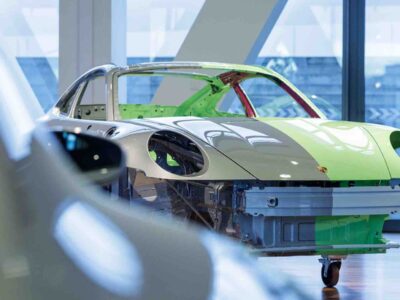(Bloomberg) —
A few weeks ago, at an RV industry showcase in Harper’s Ferry, West Virginia, I test drove an electric motorhome — a concept vehicle made by Winnebago Industries Inc. as it works on developing a commercial e-RV. More like a shuttle van with sleeping accommodations than a traditional motorhome, the concept e-RV can be charged in 45 minutes and can travel up to about 120 miles before needing a recharge.
I hopped into the driver’s seat and racheted it up to accommodate my short legs. Recalling the gray tank of my family’s Chevy Astro van circa 1992, I felt a twinge of anxiety. Then I started driving. It was asoundless, smooth ride.
Iridium debuted the first all-electric motorhome at a German trade show in 2019. Since then, the industry has raced to refine the concept. Camping and RVing, long popular in North America, now make up a $140 billion-a-year business, according to the RV Industry Association. RV makers say they were able to connect with a younger, more diverse demographic after the Covid-19 pandemic shuttered stores and offices in 2020 and everyone headed outside. Over the past two years, the typical first-time buyer of a recreational vehicle was a millennial between the ages of 33 and 41, with an average annual income of roughly $90,000, according to online surveys the group has conducted.
- Want to lead a more climate-conscious life? Bloomberg Green wants to answer your questions. Take our brief survey and tell us what you’d like to know.
“If you don’t have a history in this lifestyle, it can get super intimidating really fast, and super frustrating,” said Christy Spencer, director of marketing and communication at Keystone RV, whose parent company is THOR Industries Inc. “So as the market has grown and new people are coming, we’ve really doubled down on innovation that makes camping more accessible.”
Thor — one of the top three RV manufacturers in the world, along with Winnebago and Forest River Inc. (which is owned by Berkshire Hathaway Inc.) — also owns Airstream Inc. This year Thor announced two high-voltage, luxury electric RV concepts, the Thor Vision Vehicle and the Airstream eStream. The eStream has an electric motor and can tow itself, so pulling it won’t drain the towing vehicle’s battery.
While the Thor concept vehicles are ready to roll, they aren’t likely to be spotted on the road anytime soon. The company is still refining the technology and user experience, and “doing a lot of advocacy” in Washington for infrastructure to support state-of-the-art electric RVs, said Renee Jones, vice president of marketing at Thor. The motorhome should be available for purchase in 2023 with the trailer following “shortly after,” she said.
The concept vehicles offer a glimpse into the future of RVing. Imagine you’re headed out for the weekend in your electric car or truck: The electric trailer you’re towing, stocked with a lithium-ion battery pack and solar panels, gives you the freedom to camp somewhere without a power hookup. A water purification system allows you to throw a hose into a lake for water.
Along your route, apps let you navigate with all kinds of helpful information: electric charging stations, RV service centers, and public lands maps. When you arrive at your destination, you use your phone to remotely back up your rig into a sun-dappled space while you sip a beer and enjoy the solitude.
Charging stations for smaller EVs in rural and remote areas are becoming more prevalent but are still not common. In June, Rivian opened three Level 3 DC fast charging sites in Colorado and California, including charges that accommodate vehicles towing trailers, as part of the company’s “adventure network.”
RVs are becoming lighter and more streamlined. They still, however, need a lot of juice, whether it’s gas or from the grid. Electric RVs have charging needs that go beyond those of smaller electric vehicles. People want to able to travel farther distances without having to recharge frequently. They also want to be able to power up electric tow vehicles and RV trailers at the same time, which would require installing special tandem charging equipment at parks and campgrounds.
Current EV infrastructure in the United States “is not geared toward e-RVs,” said Jones from Thor. RV makers say the federal government needs to play catch-up and are lobbying Congress and the Biden administration to invest in and regulate infrastructure for electric RVs.
With the number of visitors to national parks and other federal lands rising, especially in the warmer months — their mostly gas-powered cars often contributing to poor air quality there — administration officials acknowledge the government needs to do more to support the use of electrified transportation on public lands.
“I think it’s a completely fair point to say it shouldn’t just be on the private sector side to figure out how to make this happen,” said Laura Daniel-Davis, principal deputy assistant secretary of land and minerals management at the US Interior Department, during an April EV technology event in Washington sponsored by the Outdoor Recreation Roundtable. Daniel-Davis said the “public lands family” is working with the Transportation Department on a gap analysis related to EV infrastructure on public and tribal lands.
That day in West Virginia, the e-Winnebago felt big as I piloted it, and there was no rear-view mirror, which initially stressed me out. (It did have really big side mirrors.) But I completed a three-point turn with relative ease. My companion complimented me on my handling as we zipped quietly along a country road.
I could get used to this, I thought.
To contact the author of this story:
Kellie Lunney in Washington at klunney2@bloomberg.net
© 2022 Bloomberg L.P.





